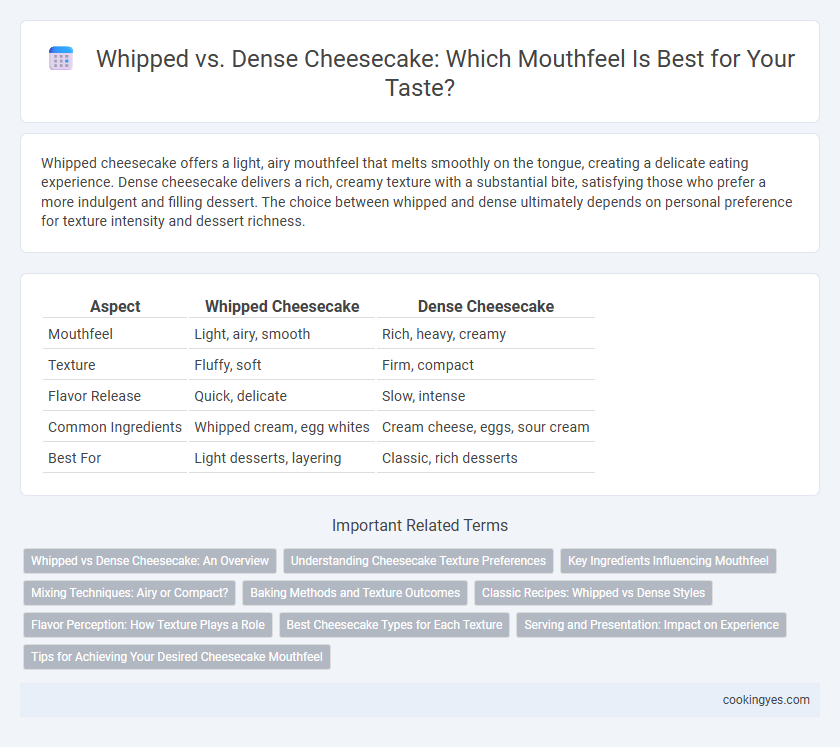Whipped cheesecake offers a light, airy mouthfeel that melts smoothly on the tongue, creating a delicate eating experience. Dense cheesecake delivers a rich, creamy texture with a substantial bite, satisfying those who prefer a more indulgent and filling dessert. The choice between whipped and dense ultimately depends on personal preference for texture intensity and dessert richness.
Table of Comparison
| Aspect | Whipped Cheesecake | Dense Cheesecake |
|---|---|---|
| Mouthfeel | Light, airy, smooth | Rich, heavy, creamy |
| Texture | Fluffy, soft | Firm, compact |
| Flavor Release | Quick, delicate | Slow, intense |
| Common Ingredients | Whipped cream, egg whites | Cream cheese, eggs, sour cream |
| Best For | Light desserts, layering | Classic, rich desserts |
Whipped vs Dense Cheesecake: An Overview
Whipped cheesecake offers a light, airy texture achieved by folding whipped egg whites or cream into the batter, resulting in a smooth, mousse-like mouthfeel. Dense cheesecake features a rich, creamy consistency with a firm structure, often made from a higher ratio of cream cheese and fewer aerating ingredients. The choice between whipped and dense cheesecakes influences not only texture but also flavor intensity and overall dessert experience.
Understanding Cheesecake Texture Preferences
Whipped cheesecakes deliver a light, airy mouthfeel with a smooth, mousse-like texture that appeals to those who prefer a less heavy dessert. Dense cheesecakes offer a rich, creamy experience with a firm, velvety consistency favored by enthusiasts seeking indulgence and depth of flavor. Understanding these texture preferences helps bakers tailor recipes to satisfy varied palate desires and enhance overall enjoyment.
Key Ingredients Influencing Mouthfeel
Whipped cheesecakes achieve a light, airy mouthfeel primarily due to the incorporation of whipped cream or beaten egg whites, which introduce air and create a fluffy texture. Dense cheesecakes rely heavily on cream cheese, eggs, and minimal aeration, resulting in a rich, creamy, and firm bite. The balance between cream cheese fat content, sugar, and carefully controlled mixing techniques directly influences the final mouthfeel by affecting moisture retention and structural density.
Mixing Techniques: Airy or Compact?
Whipped cheesecakes achieve an airy mouthfeel by incorporating more air through vigorous mixing, resulting in a light and fluffy texture. Dense cheesecakes rely on minimal mixing to maintain a compact, creamy consistency with a rich, velvety bite. The choice between mixing techniques directly influences the cheesecake's final structure, balancing between softness and firmness.
Baking Methods and Texture Outcomes
Whipped cheesecake incorporates beaten cream cheese and whipped cream, resulting in a light, airy texture with a smooth mouthfeel that melts easily on the tongue. Dense cheesecake, often achieved through minimal mixing and higher cream cheese content, delivers a rich, firm texture with a creamy, velvety bite. Baking methods such as water baths help maintain moisture and prevent cracking, enhancing the desired mouthfeel whether opting for a light or dense cheesecake.
Classic Recipes: Whipped vs Dense Styles
Classic cheesecake recipes typically vary between whipped and dense styles, each offering a distinct mouthfeel that caters to different preferences. Whipped cheesecakes deliver an airy, light texture achieved by incorporating whipped cream or whipped egg whites, resulting in a smooth and fluffy bite. Dense cheesecakes emphasize a rich, creamy consistency with a velvety mouthfeel, often using full-fat cream cheese and minimal air incorporation for a more indulgent experience.
Flavor Perception: How Texture Plays a Role
The mouthfeel of whipped versus dense cheesecake significantly influences flavor perception by altering how taste receptors engage with the creamy matrix. Whipped cheesecake, with its airy and light texture, allows flavors to disperse rapidly across the palate, enhancing sweetness and subtle undertones. In contrast, dense cheesecake delivers a concentrated, rich experience that intensifies the perception of tanginess and creaminess, making each bite more impactful and satisfying.
Best Cheesecake Types for Each Texture
Whipped cheesecakes, known for their light and airy mouthfeel, are best exemplified by classic New York-style and Japanese souffle cheesecakes, which incorporate whipped egg whites for a fluffy texture. Dense cheesecakes, favored in traditional baked varieties like Italian ricotta or Philadelphia-style, offer a rich, creamy bite with a velvety finish due to higher cream cheese ratios and less aeration. Choosing between whipped and dense textures depends on preference for either a melt-in-your-mouth softness or a firm, indulgent richness.
Serving and Presentation: Impact on Experience
Whipped cheesecakes offer a light, airy texture that enhances the serving experience by creating a visually appealing, fluffy slice that melts smoothly on the palate. Dense cheesecakes provide a rich, creamy mouthfeel, delivering a satisfying and indulgent bite that holds firm on the plate, ideal for elegant presentation. The choice between whipped and dense textures directly influences the overall sensory experience, shaping how the dessert is perceived and enjoyed during serving.
Tips for Achieving Your Desired Cheesecake Mouthfeel
Whipped cheesecake offers a light, airy mouthfeel achieved by incorporating whipped cream or egg whites, while dense cheesecake provides a rich, creamy texture through minimal air incorporation and longer baking times. To achieve a whipped texture, gently fold in whipped cream or beaten egg whites to maintain volume, and avoid overbaking to prevent dryness. For a dense mouthfeel, use full-fat cream cheese and bake the cheesecake in a water bath at a low temperature, allowing it to set slowly and develop a smooth, velvety consistency.
Whipped vs dense for cheesecake mouthfeel Infographic

 cookingyes.com
cookingyes.com